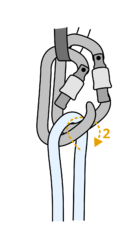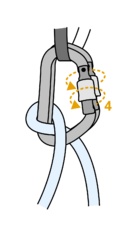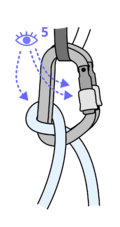Garda hitch: Difference between revisions
m Added a note regarding Tuber |
m →Tying: - girth hitch absence on image clarification |
||
| Line 13: | Line 13: | ||
== Tying == | == Tying == | ||
'''The two carabiners used for tying should be identical for the knot to work properly!''' D-shaped screw-gate carabiners are recommended. Girth hitch on the sling is recommended.<ref name=vdiff/> It is highly recommended to test the setup on the carabiners intended for garda in advance in a safe environment. | '''The two carabiners used for tying should be identical for the knot to work properly!''' D-shaped screw-gate carabiners are recommended. Girth hitch on the sling is recommended (not drawn).<ref name=vdiff/> It is highly recommended to test the setup on the carabiners intended for garda in advance in a safe environment. | ||
{{#invoke:FlexGallery|gallery|120px | {{#invoke:FlexGallery|gallery|120px | ||
Revision as of 04:44, 27 September 2025
| Garda hitch | |
|---|---|
 | |
| Use(s) | (self-)rescue techniques, material hauling |
| Pros | Fast, simple, just two carabiners needed, works well on a tested setup |
| Cons | Works only one-way, almost impossible to release when loaded, high friction under load, can slip in specific cases, the system misbehaves with some carabiners[1][2] |
| Category | Hitch |
| Strength | rope: slipping ~35% (specific cases), breaking ~45-60%[3] |
Garda hitch is one of the elementary hitches used among other applications in crevasse self-rescue. Although its simple and works reliably on tested setups, its application scope is limited by its unidirectional nature and high friction under load. In some very specific cases, it has possible safety issues, carabiner choice and testing prior to use is crucial for the systems reliability. In many applications, garda hitch can be replaced with a tuber with guide mode.
Tying
The two carabiners used for tying should be identical for the knot to work properly! D-shaped screw-gate carabiners are recommended. Girth hitch on the sling is recommended (not drawn).[1] It is highly recommended to test the setup on the carabiners intended for garda in advance in a safe environment.
Carabiner choice
Screw-gate carabiners are safe to use as long as the locks are not too bulky for the carabiner to snap properly. Due to the movement of the rope in a system, carabiners without gate lock might unclip themselves.[2] D-Shaped carabiners are recommended over other shapes.[1][3]
Slippage
Garda hitch is prone to slip in some cases, as illustrated and studied by Ryan Jenks (HowNOT2).[3] In general, the smaller the rope diameter and the bigger/more round the carabiners, the higher the chance that the hitch slips. The lowest recorded slippage force was at just 2.4 kN (oval screw-gate carabiners used together with 6mm nylon sling). In case of a 9 mm nylon rope, limit force was generally around 8-10 kN (desheating) except for the oval screw-gate carabiners (6 kN, slipping). As 8-10 kN is roughly twice of a force climber experiences during a lead fall, slippage should not be an issue as long as a climbing rope together with D-shaped carabiners is used.
References
- ↑ 1.0 1.1 1.2 Maddaloni, Matt; Chelton, Neil. "The Garda Hitch (Alpine Clutch)". VDiffClimbing.com. VDiff Climbing. Archived from the original on 12 May 2025. Retrieved 27 September 2025.
- ↑ 2.0 2.1 Godino, John. "Pros and cons of the Garda Hitch". AlpineSavvy.com. Alpinesavvy LLC. Archived from the original on 27 September 2025. Retrieved 27 September 2025.
- ↑ 3.0 3.1 3.2 Jenks, Ryan (4 September 2024). Could you survive with just 2 carabiners?. HowNOT2. Retrieved 16 August 2025.




